Tropical Dream Center
- HOME
- Facilities
- Tropical Dream Center
- Exhibition information
- Bougainvillea
Bougainvillea
It is a Nyctaginaceae shrub or vine plant with 18 known species of foundation stock originating in South America. It was first discovered by the French botanist Philibert Commerson in Rio de Janeiro, Brazil in the 1760s. The name Bougainvaillea was named after his friend sailor Louis de Bougainville.
The origin of most of the species that are currently grown are said to be crossbreed or bud variation of these three foundation stocks, B. glabra Choisy, B. spectabilis Wild and B. peruviana Humb et Bonql, as well as B. X buttiana, which is a crossbreed of B. glabra Choisy and B. peruviana Humb Et Bonql. Grown in Japan, this flower, which is said to be a native species in Okinawa, and has a surprisingly broad climate range, and, can be grown outdoors as far as the southern end of Izu Peninsula. However, it is limited to the coastal region where there is no frost.
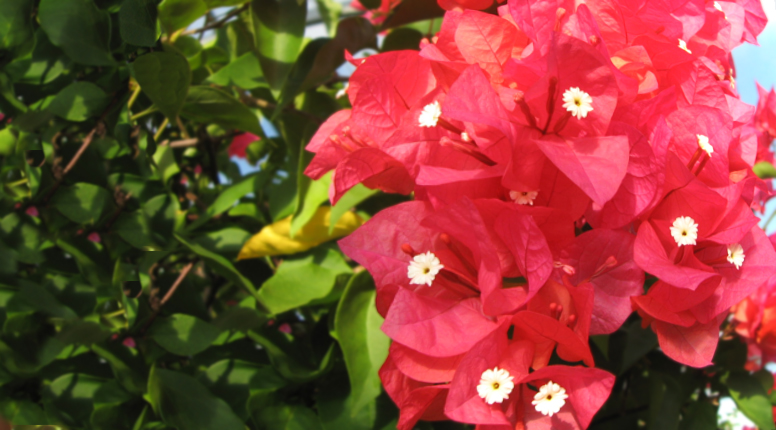
Growing Area in Japan
The area for this flower in Japan is surprisingly broad, and Sanderiana, which is said to be a native species in Okinawa, can be grown outdoors as far north as the southern end of Izu Peninsula. However, it is limited to the coastal region where there is no frost.
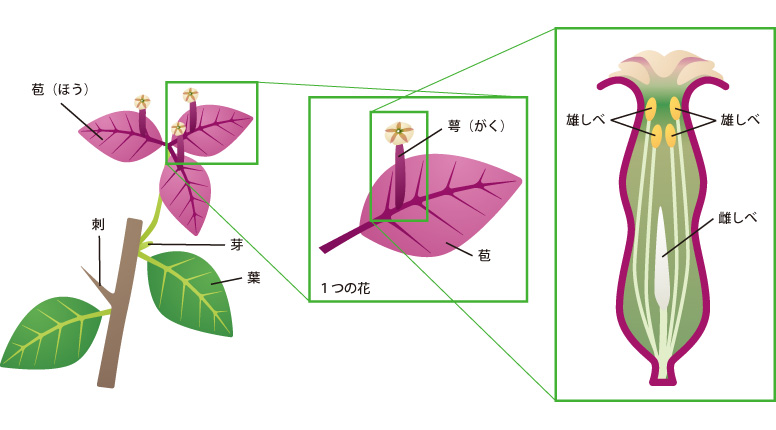
Feature of flower
What looks to be a petal on the Bougainvaillea is the bract, a leaf that has changed its form. If it is a single flower, there are three bracts in one set and each bract has a flower, and above the vein in the center of the bract is a thin tubular calyx of about 0.4-0.8 inches. Inside the calyx are one stamen and eight pistils.
Bracts come in various shapes and sizes. There are shapes such as ones with a sharply pointed tip like Sanderiana, ones that are oval, and ones with margins curling inwards. There are colors such as white, pink, red, purple, yellow, orange, white with red veins, white with purple gradation and white with pink gradation. Bracts are truly rich in variation.
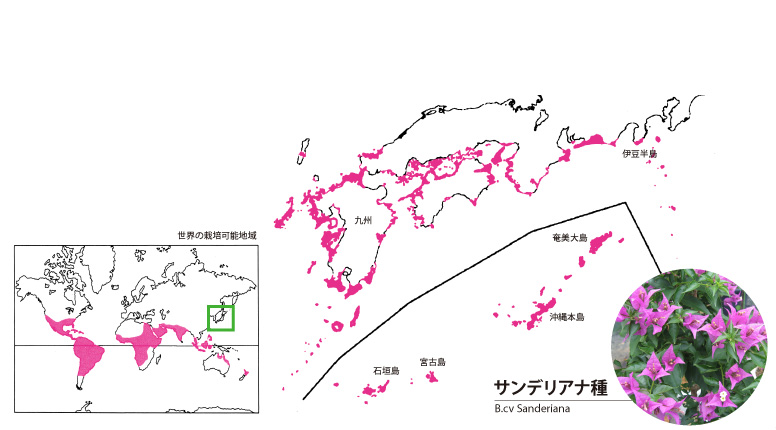
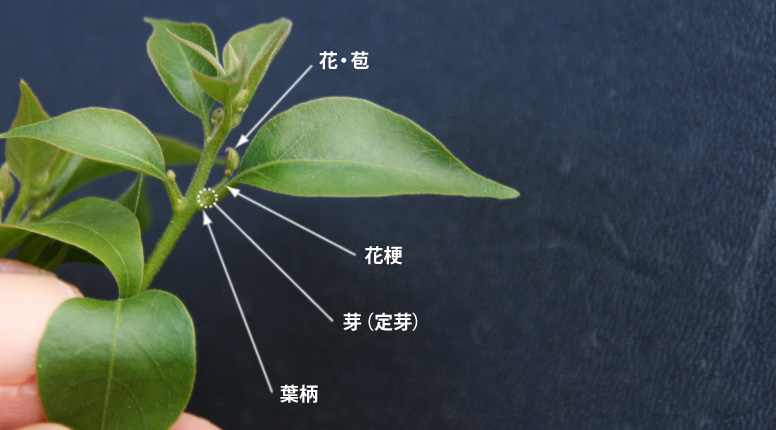
The flower bud grows above the bud at the base of the stem.
The tip of the peduncle is swollen as shown in this picture. The bract develops from here. In conditions that are unsuitable for the formation of the flower bud such as high temperature and long exposure to sunlight, the bud does not become a flower and remains a prickle.
Species of Bougainvillea
B. glabra(B.glabra)
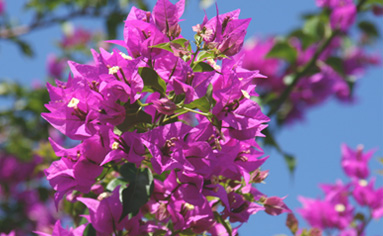
(B.'Sanderiana')
B.glabra is native to Brazil and has many abnormally long and thin branches and grows many relatively small bracts. The species introduced here is said to have originated from B. glabra.
A representative species of B. glabra, which is said to be a native species in Okinawa, is resistant to cold and grows as far north as the southurn end of Izu Peninsula as long as it is a coastal region where there is no frost. The bract has a sharp tip and is slightly opened, and the leaf is shiny.
B. x buttiana(B.xbuttiana)
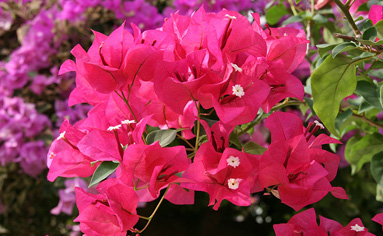
'Mrs.Butt'
(B.×buttiana) which stands for Mrs. Butt is said to be a mixture of the foundation stocks B. Glabra and B. Peruviana, and there are many species that are bud variations of this species such as those that are double flowered and those that are in various colors such as red, yellow and orange.
This became the parent body of many species. Its bract is dark red, and its peduncle is slightly twisted and reddish.
Double flower
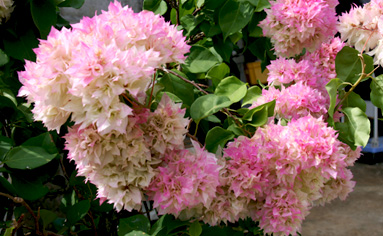
Candle
Though the bract of the double-flowered species of Bougainvillea is small compared to that of a single flower, many bracts grow in a lump, which appear gorgeous. As opposed to a single flower, which grows one flower per bract, the double flower in this picture has 18 bracts to one flower. However, the number of bracts differs depending on the species and the conditions of the root,
It grows straight up, has many branches, and grows flowers in a group on the tip of the branches, which hide in the leaves.
Others
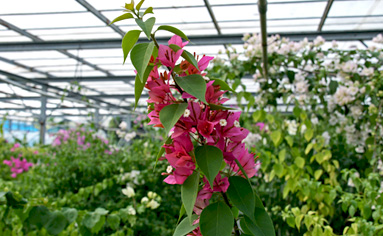
Bridal bouquet
Although Bougainvillea has a strong impression that if it’s left growing wildly, it grows many branches and eventually gets out of hand, but there are some that grow straight up and stay compact with branches that do not grow much. There are others that do grow straight up and have many branches and bracts that face up, and others with small leaves in order to withstand dryness.
White with a shade of red on the tip
Variegated leaf
There are many types of variegated leaves of Bougainvillea such as those with spots at the edge of the leaf commonly called “Outer spots (Sotofu)”, those with spots in the inner part called “Inner spots (Uchifu)”, and those with many blotches called “Sand spots (Sunagofu)”.
The beauty of the flower is that it can be enjoyed even when the it is not blossoming.
Outer spots
Red, white colored B. glabra
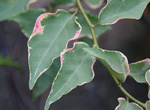
Outer spots
White colored B. x buttiana

Outer spots
Yellow colored B. x buttiana
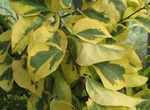
Outer spots
B. glabra

Mosaic spots
White colored B. peruviana Humb et Bonql
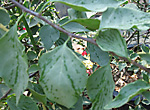
Inner spots
Mary Palmer
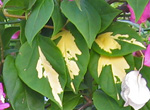
Sand spots
Yellow colored B. x buttiana
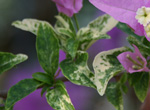
Sand spots
B. glabra

How to grow Bougainvillea
Bougainvillea grows vigorously and relatively receives little damage from diseases and insects, and as a garden tree, it is so easy to grow because it will not die even without water or fertilizer.
On the other hand, if left growing wildly, they will grow branches in every direction and become out of hand. Furthermore, because it has sharp prickles, it is very hard to prune. Therefore, daily managing tasks become essential for growing many beautiful flowers.
Characteristics
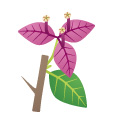
Although there are occasions when floral buds appear even in the summer when the day is long, flower-bud formation is more stimulated in spring and autumn when the day is short. This type of plant is called Relativity Short Day Plant and the Hibiscus also has this characteristic. The suitable temperature for flower-bud formation is said to be 68-77℉ during the day and 50-55.5℉ at nighttime, hence flowering season in Okinawa is between autumn and spring. However, when the growth of stems and leaves is held back due to conditions such as dryness, flower buds are formed even in the summer.
Suitable environment

Preferably a place with lots of sunshine. It does not flower well in the shade. When planting it in the garden, select a place where there is sunlight in the morning.
Watering

Although it depends on the condition of the tree, moderately water during the growth season in the summer, and provide plenty of water after transplanting or during the blooming season. If it dries out during the blooming season, the flowers will drop.
Fertilizer
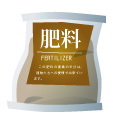
When growing in a pot, provide fertilizer with high phosphoric acid at the time of transplanting, blooming season, and after pruning at the end of the flowering season. It is also said that chemical fertilizer is good for preventing the leaf color from getting pale. It is not necessary when growing in the garden.
Pruning

Remove abnormally long branches from the part where it separates leaving about five leaves. Then, when the tip of the branch sticks out, remove it just like the abnormally long branch, and let the branches and leaves grow further. After blooming, remove the branch where flowers were growing.
Transplantation

Transplant when pot is clogged with roots, which is said to be about once every three years. Cut off about 1/3 of the root clump and transplant it into a pot that’s a little larger. Soil for transplanting can be anything as long as water drainage is good.



























